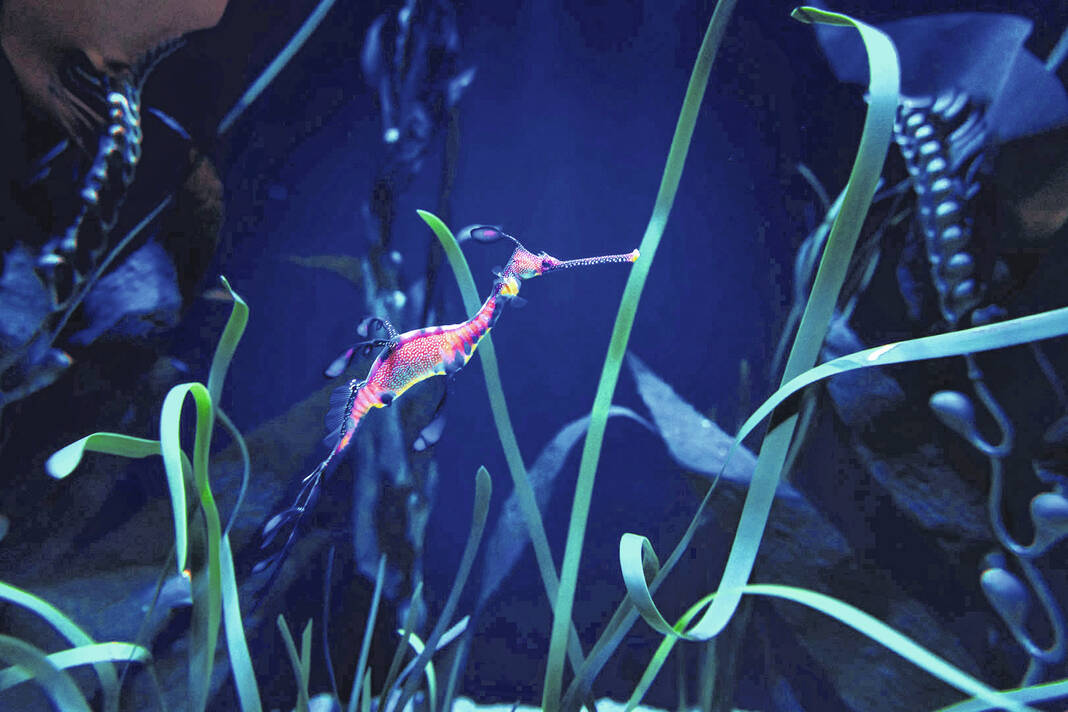
Pictured is a weedy seadragon.
Grahm S. Jones | Columbus Zoo and Aquarium
POWELL – New this spring, guests visiting the Columbus Zoo and Aquarium will discover the aquatic world of a unique species — the weedy seadragon! Located in the Australia and the Islands region’s Nocturnal Building and Aviary, the weedy seadragon habitat highlights the Columbus Zoo’s continued commitment to preserving diverse ecosystems and the species that depend on these habitats. This new habitat will officially open to the public on Monday, April 10.
Despite their mystical name, weedy seadragons, or “weedies,” are not related to dragons and are a fish species more closely related to seahorses. Unlike many other fish, they do not have scales. Instead, their thin skin is stretched over bony plates that look like rings around their tails. They have fused jaws so their mouths (coronet) are like tubes, giving their heads a horse-shape appearance. They use their mouths to suck in fish eggs and small crustaceans drifting in the water. Unlike seahorses that have a pouch, after weedy seadragons reproduce, the eggs stick to a male’s brood patch under his tail. Weedies are the largest of seadragon species (growing to a foot-and-a-half long), and they are quite striking in appearance with their beautiful coloration of red and orange with light yellow and purple features.
As guests approach the Zoo’s Nocturnal Building and Aviary, they will notice an updated building exterior, complete with new props and engaging signage that sets the tone for the beauty that awaits them inside. Upon entering the building, they will then encounter a vibrant underwater-themed environment that includes 10 foot high murals, custom painted artwork, and unique projection animation — all leading to an impressive 6-foot tall, 5-foot-deep, and 10-foot-long weedy seadragon habitat. A custom-made curved acrylic viewing window encourages guests to enjoy these beautiful creatures while learning more about conservation actions that can help protect their future.
“We are delighted to showcase these amazing members of the seahorse family. Weedy seadragons are exquisite fish, so well adapted to their environment. I know that our guests and members will be excited to see them, learn about them, and understand what we all can do to help protect our oceans and seas,” said Tom Schmid, president and CEO of the Columbus Zoo and Aquarium.
Like seahorses, seadragons face conservation challenges. Runoff from home and industrial fertilizer, plastics, and other litter pollute their aquatic habitats. Climate change is causing changes in water temperature, habitat, and prey availability. In 2022, a mass die-off event occurred when more than 200 seadragons washed upon shore from the Great Southern Reef after severe storms, drawing particular concern from conservationists. Additionally, there is unregulated or illegal trade in seahorses worldwide for use in traditional medicine. Finally, a major threat to sea life in general is bottom trawling. Large weighted nets are dragged by commercial fishing operations to catch fish and shrimp for seafood. This destroys seafloor habitat and collects non-target species or “by catch.” Project Seahorse estimates that about 70 million seahorses are caught worldwide per year as part of this non-selective fishing.
While weedy seadragons are currently listed by the International Union for Conservation of Nature’s Red List of Threatened Species™ as “Least Concern,” seadragons are fully protected in their native waters around Australia. International and national ocean policies, treaties, and regulations are helping seahorses and seadragons, but additional actions can help make a difference. These options include using less fertilizer and plastics, picking up litter, recycling, and ensuring that seafood is sustainably harvested.
The Columbus Zoo’s Nocturnal Building and Aviary has been closed to the public since construction began on the weedy seadragon habitat began in September 2022. In addition to visiting the weedies, guests can welcome back familiar faces, including various bird species, binturongs, tree kangaroos, feathertail gliders, and Glen the wombat.
The weedy seadragon project was funded in part through a Community Parks, Recreation and Conservation Project by the Ohio Department of Natural Resources.
For additional updates about the Columbus Zoo, events, and more, be sure to follow the zoo’s social media accounts on Facebook, Instagram, Twitter, and TikTok, and visit us at ColumbusZoo.org.
Information for this story was provided by the Columbus Zoo and Aquarium.

